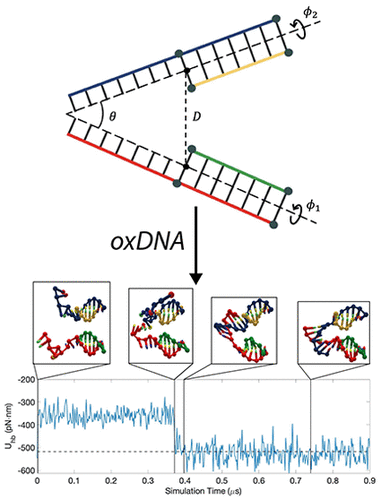当前位置:
X-MOL 学术
›
J. Phys. Chem. B
›
论文详情
Our official English website, www.x-mol.net, welcomes your
feedback! (Note: you will need to create a separate account there.)
Coarse-Grained Simulations of DNA Reveal Angular Dependence of Sticky-End Binding
The Journal of Physical Chemistry B ( IF 2.8 ) Pub Date : 2021-04-19 , DOI: 10.1021/acs.jpcb.1c00432
Nicholas M. Gravina 1 , James C. Gumbart 1 , Harold D. Kim 1
The Journal of Physical Chemistry B ( IF 2.8 ) Pub Date : 2021-04-19 , DOI: 10.1021/acs.jpcb.1c00432
Nicholas M. Gravina 1 , James C. Gumbart 1 , Harold D. Kim 1
Affiliation

|
Annealing between sticky ends of DNA is an intermediate step in ligation. It can also be utilized to program specific binding sites for DNA tile and origami assembly. This reaction is generally understood as a bimolecular reaction dictated by the local concentration of the sticky ends. Its dependence on the relative orientation between the sticky ends, however, is less understood. Here we report on the interactions between DNA sticky ends using the coarse-grained oxDNA model; specifically, we consider how the orientational alignment of the double-stranded DNA (dsDNA) segments affects the time required for the sticky ends to bind, τb. We specify the orientation of the dsDNA segments with three parameters: θ, which measures the angle between the helical axes, and ϕ1 and ϕ2, which measure rotations of each strand around the helical axis. We find that the binding time depends strongly on both θ and ϕ2: ∼20-fold change with θ and 10-fold change with ϕ2. The binding time is the fastest when the helical axes of duplexes are pointing toward each other and the sticky ends protrude from the farthest two points. Our result is relevant for predicting hybridization efficiency of sticky ends that are rotationally restricted.
中文翻译:

DNA的粗粒模拟揭示了粘性末端结合的角度依赖性
DNA粘性末端之间的退火是连接的中间步骤。它也可以用来为DNA瓷砖和折纸组装程序编程特定的结合位点。该反应通常被理解为由粘性末端的局部浓度决定的双分子反应。然而,对于粘性末端之间的相对取向的依赖性却鲜为人知。在这里,我们使用粗粒oxDNA模型报告了DNA粘性末端之间的相互作用。具体地,我们考虑双链DNA(dsDNA)的链段的取向对准如何影响为粘性末端结合,τ所需的时间b。我们使用三个参数指定dsDNA片段的方向:θ(用于测量螺旋轴之间的角度)以及ϕ 1和ϕ 2,用于测量每条股线围绕螺旋轴的旋转。我们发现,结合时间在很大程度上取决于双方θ和φ 2:与θ和φ用10倍〜20变倍的变化2。当双工螺旋轴相互指向并且粘性末端从最远的两个点突出时,装订时间最快。我们的结果与预测受旋转限制的粘性末端的杂交效率有关。
更新日期:2021-04-29
中文翻译:

DNA的粗粒模拟揭示了粘性末端结合的角度依赖性
DNA粘性末端之间的退火是连接的中间步骤。它也可以用来为DNA瓷砖和折纸组装程序编程特定的结合位点。该反应通常被理解为由粘性末端的局部浓度决定的双分子反应。然而,对于粘性末端之间的相对取向的依赖性却鲜为人知。在这里,我们使用粗粒oxDNA模型报告了DNA粘性末端之间的相互作用。具体地,我们考虑双链DNA(dsDNA)的链段的取向对准如何影响为粘性末端结合,τ所需的时间b。我们使用三个参数指定dsDNA片段的方向:θ(用于测量螺旋轴之间的角度)以及ϕ 1和ϕ 2,用于测量每条股线围绕螺旋轴的旋转。我们发现,结合时间在很大程度上取决于双方θ和φ 2:与θ和φ用10倍〜20变倍的变化2。当双工螺旋轴相互指向并且粘性末端从最远的两个点突出时,装订时间最快。我们的结果与预测受旋转限制的粘性末端的杂交效率有关。































 京公网安备 11010802027423号
京公网安备 11010802027423号